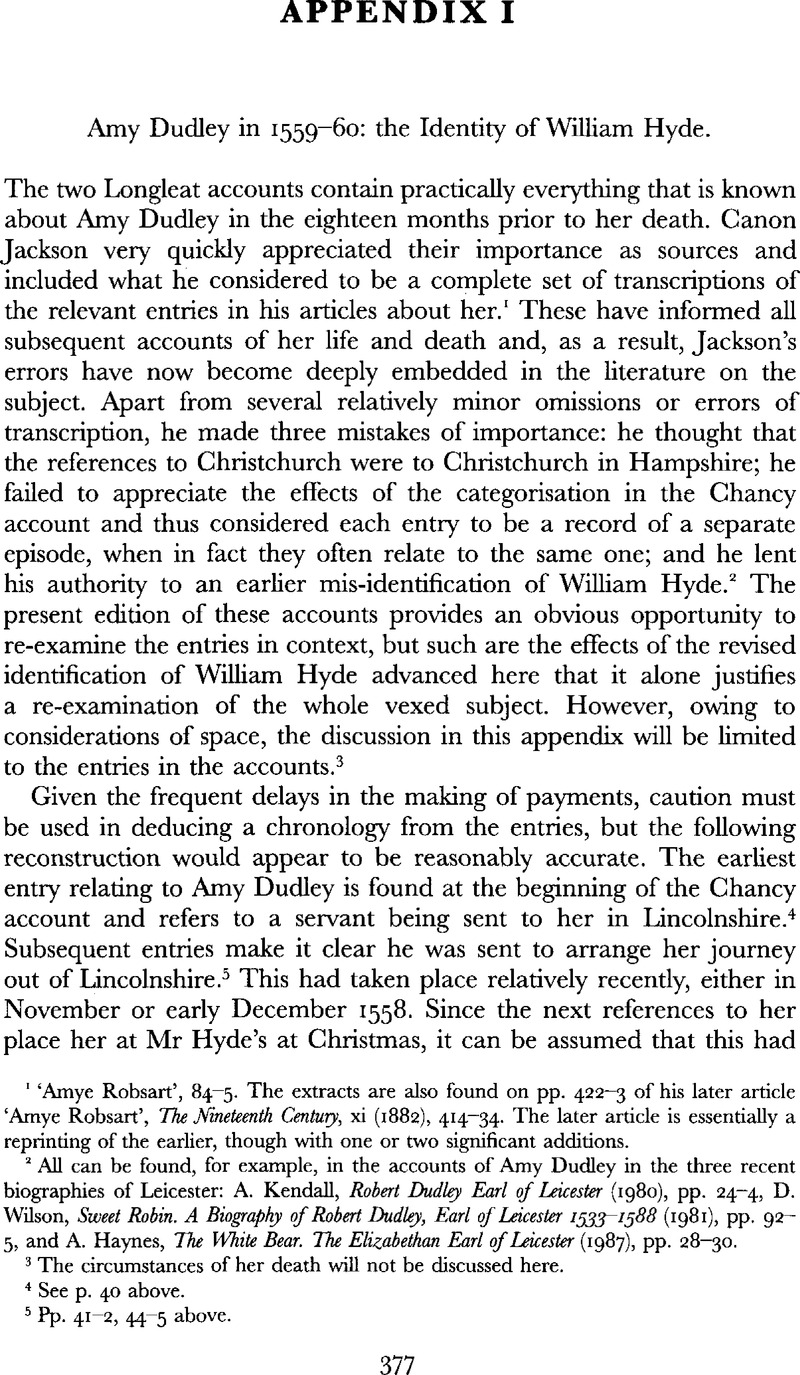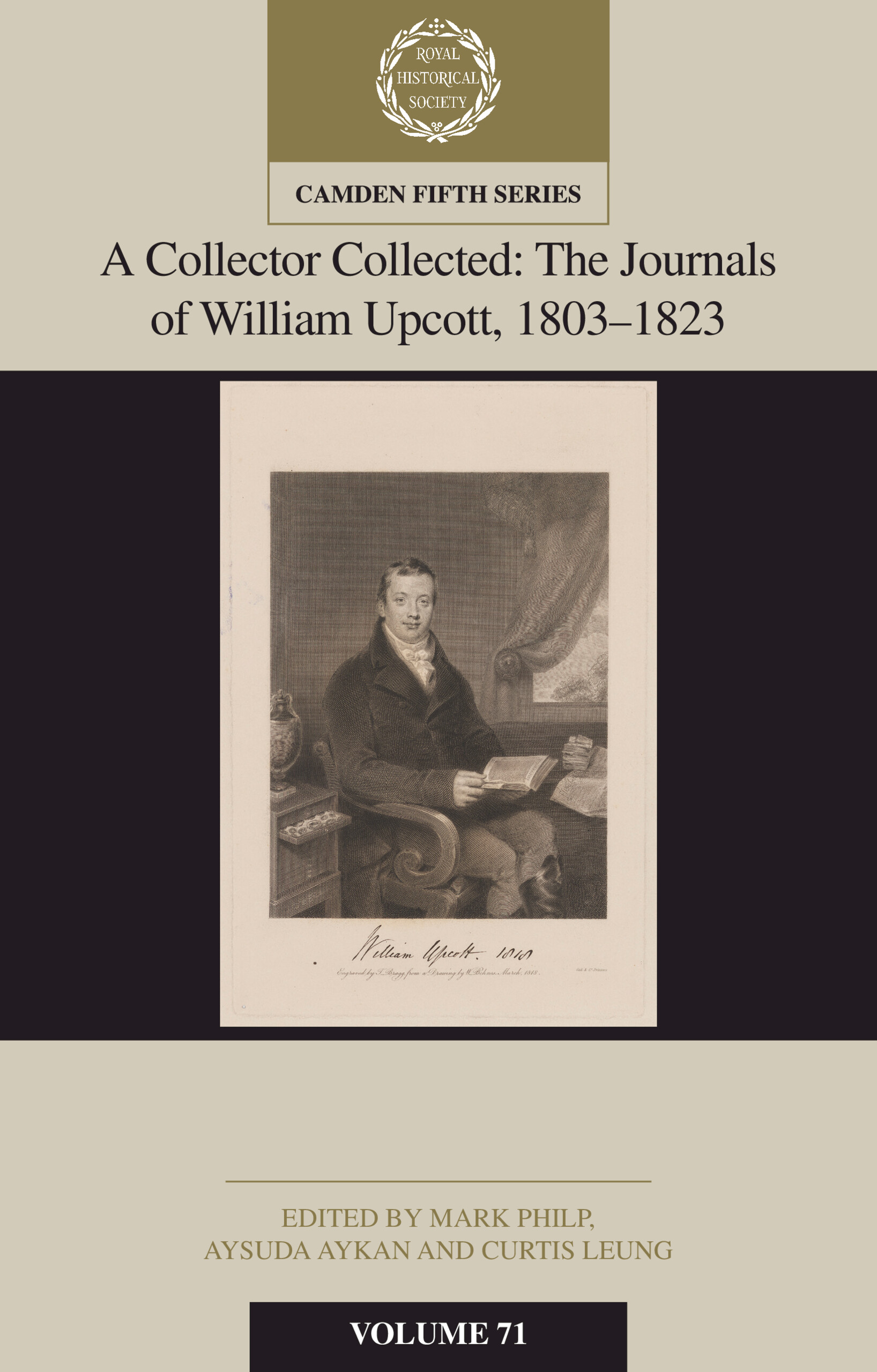No CrossRef data available.
Article contents
Appendix I: Amy Dudley in 1559–60: the Identity of William Hyde
Published online by Cambridge University Press: 13 October 2009
Abstract

- Type
- Part I. Household Accounts and Disbursement Books
- Information
- Copyright
- Copyright © Royal Historical Society 1995
References
1 ‘Amye Robsart’, 84–5. The extracts are also found on pp. 422–3 of his later article ‘Amye Robsart’, The Nineteenth Century, xi (1882), 414–34Google Scholar. The later article is essentially a reprinting of the earlier, though with one or two significant additions.
2 All can be found, for example, in the accounts of Amy Dudley in the three recent biographies of Leicester: Kendall, A., Robert Dudley Earl of Leicester (1980), pp. 24–4Google Scholar, Wilson, D., Sweet Robin. A Biography of Robert Dudley, Earl of Leicester 1533–1588 (1981) pp. 92–5Google Scholar, and Haynes, A., The White Bear. The Elizabethan Earl of Leicester (1987), pp. 28–30.Google Scholar
3 The circumstances of her death will not be discussed here.
4 See p. 40 above.
5 Pp. 41–2, 44–5 above.
6 Pp. 41–2, 54 above.
7 They are found under Foreign charges, p. 60, Diet, pp. 94–5 and Playing money, p. 99. The reference to 8 April is found in the next entry but one under Playing money.
8 See p. 95.
9 Pp. 64–5, 68, 71, 102–3.
10 The first reference is found on p. 64.
11 See pp. 71, 90–1. The entry on p. 68 suggests that she went back to Camberwell from Christchurch and departed from there, but it is difficult to be categorical.
12 These were not errors of ignorance; Scott believed that as a writer of romances he was ‘at liberty to commit anachronisms for the sake of effect’ (Anderson, J., Sir Walter Scott and History (Edinburgh, 1981), p. 31Google Scholar, see also pp. 27–36 passim, and on Kenilworth itself, p. 80).
13 Wright, , i, 48–9Google Scholar. He criticises Scott's errors and anachronisms at some length. The original of the letter is Harl. MS 4712, fo. 275, a volume of papers of Norfolk origin collected by Peter Le Neve. It has been reprinted on numerous occasions since, most recently by Wilson, pp. 94–5.
14 Pepys MS 2503 (Letters of State II), pp. 703–11.
15 They were published simultaneously in Braybrooke, 's Diary of Samuel Pepys F.R.S. (4th ed., 1848), i, 381–8Google Scholar, and Craik, G.L., The Romance of the Peerage (1848)), i, 399–407Google Scholar. They have been reprinted in various forms since, but none of the various transcriptions are to be relied on (see n. 161 above).
16 An Historical and Descriptive Account of Cumnor Place, Berks. (Oxford, 1850), pp. 34–5Google Scholar. This is the first work to identify Hyde that I know of. It is still one of considerable value. Bartlett, who later became the Berkshire county coroner, knew his local sources well, and Jackson consulted him about the possible survival of the verdict of the inquest into Amy Dudley's death (‘Amye Robsart’, 76).Google Scholar
17 ‘Amye Robsart’, 63Google Scholar. By the time he wrote his later ‘Amye Robsart’ article, Jackson had discovered (see p. 421) that Hyde's father, the elder William Hyde, had purchased the manor of Kingston Lisle (Berks.) from Northumberland in the 1530s, but that is the extent of the connection.
18 See Hasler sub Anthony Forster and William Hyde for good examples of the way in which the identification has influenced modern scholarship. There has been one sceptic, the author of the Cumnor and District Historical Society pamphlet Amy Robsart and Cumnor Place.
19 Fo. 353. This is not the place to discuss any of the other very interesting aspects of this account.
20 See pp. 60, 94–5.
21 The exception is the entry to Anthony Forster's servant discussed below.
22 Cussans, J.E., History of Hertfordshire: Hundred of Odsey (1873), pp. 150–3Google Scholar, prints Hyde's will and a Hyde pedigree. See also V.C.H., Hertfordshire, iii, 274Google Scholar; iv, 112. It would appear from the entries on pp. 150–1 that Hyde was in Leicester's company in January 1560.
23 Jackson, who appreciated that the letter could be dated as early as 1557, was almost explicit about this, see ‘Amye Robsart’, 61. Cf. Wilson, pp. 94–5.
24 On 7 August 1559 Leicester was at Nonsuch with the court (see p. 78 above) and had not (apparently) seen his wife since June.
25 See n. 28 below. Her letter also refers to William Grice in connection with the business at hand in such a way that it must have been written in the period of his account rather than Chancy's.
26 See ‘Dudley Clientèle’, p. 251Google Scholar, and Introduction, n. 52. The letter fits quite neatly into the chronology of the departure of the St Quentin expedition, but there is no space to discuss it here. The references to Grice pose no difficulty for he is found acting as an attorney for Leicester as early as March 1556 (BRL, HH MS 351614). The business referred to could have been handled easily by Leicester if he had departed from Hyde's to London; his leaving it to his wife to conclude makes more sense if he was intending to cross the Channel.
27 ‘Dudley Clientèle’, p. 251.Google Scholar
28 This is the subject of his letter to Flowerdew, Harl. MS 4712, fo. 273. It could not have been written in 1559 and in late July 1557 he was deeply involved in the preparations for the St Quentin expedition.
29 The couple were probably together when they signed the documents for the conveyance of Hales Owen on 27 March 1558 (BRL, HH MSS 351493 and 390016). Conversely, Amy Dudley could have spent part of the time at Christchurch.
30 See ‘Feria Letter’, n. 28, and ‘Dudley Clientèle’, p. 253Google Scholar. His presence on 28 November is noted in Machyn, 180, and the warrant of the 23rd is referred to in A. Kempe (ed.), The Loseley Manuscripts (1836), p. 65Google Scholar. The chronology of the Chancy account suggests that Amy Dudley was in Lincolnshire at the date of the accession, had she been sent there to keep her safely out of the way in case there was trouble?
31 P. 41.
32 P. 55.
33 Pp. 92, 106.
34 A letter from Verney to Leicester of 20 April 1560 survives (DP TV, fo. 10). It does not mention her, but apologises for the death of some of Leicester's hawks which were in the keeping of a cousin of Verney's in Warwickshire.
35 P. 133.
36 P. 102.
37 Her reasons for going to Suffolk can only be guessed at. The Robsart estate had included the manor of Bulkham in Suffolk, but Leicester had sold it in 1557 (see ‘Dudley Clientèle’, p. 251).Google Scholar
38 For Windsor Castle see n. 299 above. For the Warwickshire negotiations see ‘West Midlands’, 31.Google Scholar
39 His proposed visit to Huntingdon at Ashby de la Zouche in June (see n. 277 above) is worth noting in this context.
40 See p. 13, n. 52 to the Introduction.
41 In his initial report on her death of 11 September (Pepys MS 2503, p. 705), Thomas Blount referred to ‘her people that waited upon her’ and ‘her sorte’. For Mrs Picto and Huggenes, see nn. 161, 262 above. The 1559 livery lists (p. 421) include hose delivered to ‘thre of those that wayteth on my lady’.
42 For the letter to Edney and his bill see n. 236 above.
43 The bill is printed in Jackson, ‘Amye Robsart’, 85–8Google Scholar. The dress mentioned in the entry dated 6 July appears to be the one referred to in her letter of 24 August, and presumably had been delivered by then. The various items are sub-divided into groups of parcels, two delivered to Richard Ellis and two to William Grice. This may mean that the bill goes back to the period of Grice's account.
44 See n. 262 above.
45 See pp. 173, 175 above.


